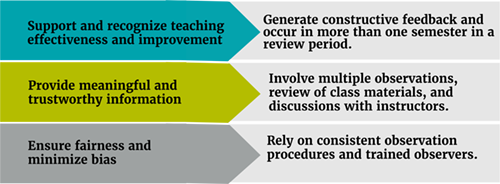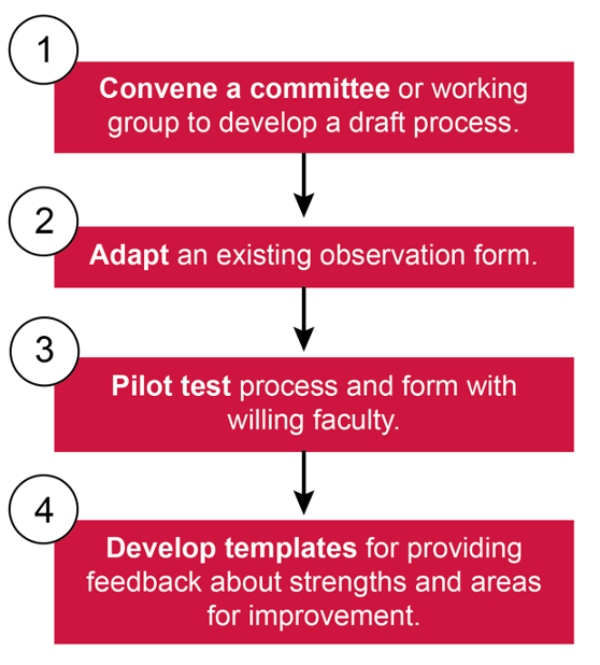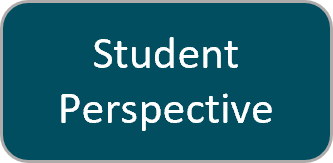Peer Perspective
The peer perspective for evaluation of teaching effectiveness involves relying on trained peers to review class materials, observe class sessions, and discuss goals and observations with the instructor.
Using the peer perspective can achieve important goals (below left) via robust practices (below right).

Click for a text version of the Peer Perspective graphic. (PDF)
Decision Guide
The following are guiding questions departments and other units can consider as they develop peer observation processes. Click on each title to expand (or collapse) each box.
Having clearly defined tools for use with peer observations helps to increase fairness because it helps to ensure that the same criteria are considered for all instructors.
Questions to Ask:
- What observation form will the department use?
- What templates will the department use for providing feedback to instructors or for producing reports for promotion & tenure decisions?
Having standard processes helps to ensure fairness across those being observed, and produces more trustworthy information on which to make evaluations.
Questions to Ask:
- What process or criteria will be used to select peer observer(s)?
- How many class sessions will be observed?
- How many faculty will be observers?
- Which class materials will be reviewed?
- How often will peer evaluation be done?
When will peer evaluation be formative (i.e., only to provide feedback) and when will it be summative (i.e., formal feedback for evaluation)?
Designing processes to document change recognizes effort toward improvement, rather than just excellence.
Question to Ask:
- Will peer observation be repeated within a review period so that teaching improvements can be documented?
Question to Ask:
- How will peer observers be trained?
- How will workload be allocated for planning and conducting observations?
- When and how will the peer evaluation process be examined to improve it?
Departmental Quick Start Guide

UGA Feature: The Department of Genetics uses the Peer Perspective
The Department of Genetics developed a new peer evaluation process to mentor faculty in improving their teaching and to make teaching evaluation more fair than was possible using only student evaluations. The department made progress by forming a committee, prioritizing the goal of providing useful feedback to faculty, and adapting an existing form.
- The chair recognized that some faculty had peer observations and some had not. The observations that occurred were inconsistent and not useful for faculty to improve.
- The chair convened a four-member Teaching Mentoring Committee to develop and refine a peer observation process.
- The committee selected and adapted an observation form from another institution. They identified willing faculty to pilot test the process, prioritizing junior faculty.
- Based on the pilot, the committee made refinements to increase feasibility and maximize usefulness for the instructor and the department.
- The committee later expanded to 6 members, with new members joining after experiencing the process themselves.
- Each committee member observes and provides feedback to 2-3 colleagues per year.
- An observation form outlines the full process and focuses on three key dimensions of teaching. The instructor can choose 1-2 additional dimensions for feedback if they want. Each dimension is illustrated with many examples.
- Two observers each attend a different class period based on their availability. The department opted for one observation per observer (i.e., two total for each instructor) to keep the workload feasible.
- Observers spend ~3 hours total per observation: planning the observation, reviewing material, observing the class, completing the form, and meeting with the instructor before and after an observation.
- Observers use a template for providing balanced feedback to instructors about strengths and areas for improvement.
- For first-time instructors, feedback is strictly formative. Feedback is summative for 3rd year review, promotions, and for post-tenure review.
- The Teaching Mentoring Committee organizes and conducts all peer observations; this workload counts as departmental service equivalent to other committees (e.g., undergraduate or graduate affairs).
- The committee convenes annual training for observers that involves watching videos of biology classes, making observations using the form, and discussing observations.
Additional Resources
Example forms to guide peer evaluation
- Overview of Peer Observation Process (.docx) (UGA Department of Genetics)
- Sample Observation Form: Three key dimensions of teaching (.docx) (UGA Department of Genetics)
- Sample Observation Form: Select what will be observed (.docx) (University of Colorado Boulder)
- Sample Observation Form: With rating scale (.docx) (University of Colorado Boulder)
- Observation Guide for Peers & Small Groups (PDF) (University of Kansas)
- Data for Peer Feedback (Florida International University)
Guidance and templates for providing feedback
- Writing Peer Evaluation Reports, Template (.docx) (University of Georgia)
Developing departmental processes for peer evaluation
- Guide for Peer Review (PDF) (University of Oregon)
- Guide for Advancing Teaching Evaluation, Peer Voice (PDF) (University of Georgia)



